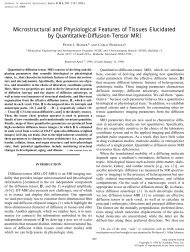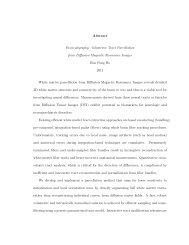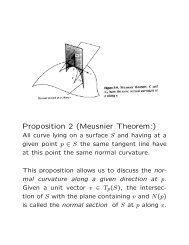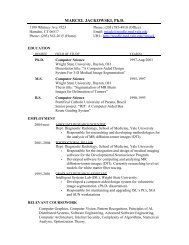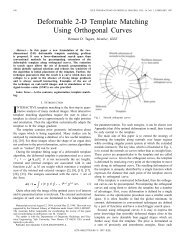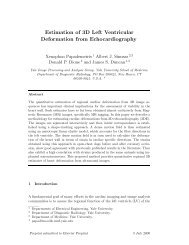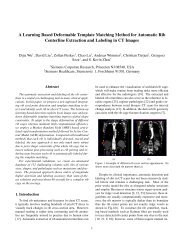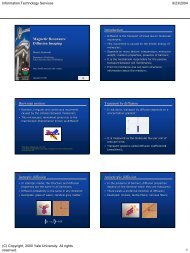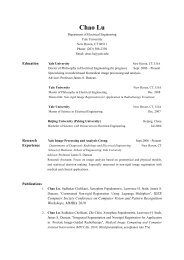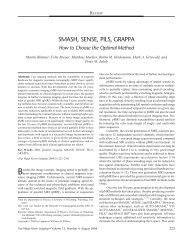pdf for printing - Image Processing and Analysis Group
pdf for printing - Image Processing and Analysis Group
pdf for printing - Image Processing and Analysis Group
You also want an ePaper? Increase the reach of your titles
YUMPU automatically turns print PDFs into web optimized ePapers that Google loves.
TCL – part 2<br />
# actor coordinates geometry, properties, trans<strong>for</strong>mation<br />
vtkActor aSphere<br />
aSphere SetMapper map<br />
[aSphere GetProperty] SetColor 0 0 1; # blue<br />
# create a renderer add the sphere<br />
vtkRenderer ren1<br />
ren1 AddActor aSphere<br />
ren1 SetBackground 1 1 1;# Background color white<br />
# create a window to render into<br />
vtkRenderWindow renWin<br />
renWin AddRenderer ren1<br />
# create an interactor<br />
vtkRenderWindowInteractor iren<br />
iren SetRenderWindow renWin<br />
vtkRenderWindowInteractor<br />
# Render an image; since no lights/cameras specified, created automatically<br />
renWin Render<br />
Java – part 1<br />
import vtk.*;<br />
public class test {<br />
// in the static constructor we load in the native code<br />
// The libraries must be in your path to work<br />
static {<br />
System.loadLibrary("vtkCommonJava"); System.loadLibrary("vtkFilteringJava");<br />
System.loadLibrary("vtkIOJava"); System.loadLibrary("vtkImagingJava");<br />
System.loadLibrary("vtkGraphicsJava"); System.loadLibrary("vtkRenderingJava");<br />
}<br />
public static void main (String[] args)<br />
{<br />
// create sphere geometry<br />
vtkSphereSource sphere = new vtkSphereSource();<br />
sphere.SetRadius(1.0);<br />
sphere.SetThetaResolution(18);<br />
sphere.SetPhiResolution(18);<br />
// map to graphics objects<br />
vtkPolyDataMapper map = new vtkPolyDataMapper();<br />
map.SetInput(sphere.GetOutput());<br />
// actor coordinates geometry, properties, trans<strong>for</strong>mation<br />
vtkActor aSphere = new vtkActor();<br />
aSphere.SetMapper(map);<br />
aSphere.GetProperty().SetColor(0,0,1); // color blue<br />
Programming Languages<br />
Mapper<br />
Actor<br />
Renderer<br />
Render<br />
Window<br />
Source<br />
Mapper<br />
Actor<br />
• Interpreted vs Compiled Languages<br />
– Note that classic distinction is blurring thanks to onthe-fly<br />
compilers (e.g. Tcl 8.x)<br />
• Interpreted Languages<br />
– e.g. BASIC, Matlab, Tcl, Python, Perl …<br />
– Fast development, computationally inefficient<br />
• Compiled Languages<br />
– e.g. C/C++, Fortran, Java(?)<br />
– Computationally more efficient but extra step in<br />
development cycle<br />
#include "vtkSphereSource.h"<br />
#include "vtkPolyDataMapper.h"<br />
#include "vtkActor.h"<br />
#include "vtkRenderWindow.h"<br />
#include "vtkRenderer.h"<br />
#include "vtkRenderWindowInteractor.h"<br />
C++ – part 1<br />
void main ()<br />
{<br />
// create sphere geometry<br />
vtkSphereSource *sphere = vtkSphereSource::New();<br />
sphere->SetRadius(1.0);<br />
sphere->SetThetaResolution(18);<br />
sphere->SetPhiResolution(18);<br />
vtkPolyDataMapper *map = vtkPolyDataMapper::New();<br />
map->SetInput(sphere->GetOutput());<br />
// actor coordinates geometry, properties, trans<strong>for</strong>mation<br />
vtkActor *aSphere = vtkActor::New();<br />
aSphere->SetMapper(map);<br />
aSphere->GetProperty()->SetColor(0,0,1); // sphere color blue<br />
…<br />
}<br />
Source<br />
Mapper<br />
Actor<br />
Comment on Language Selection<br />
• VTK can be used from any one of C++/Java/Tcl<br />
<strong>and</strong> Python<br />
• Some features not accessible from the scripting<br />
languages<br />
• In Java/Tcl/Python our own code can:<br />
– Be used to join st<strong>and</strong>ard VTK elements in a pipeline<br />
– Call existing VTK routines<br />
• In C++ we can do all of the above plus<br />
– Write new filters/sources etc as required (which can in<br />
turn be used from the other languages)<br />
Interpreted Languages<br />
• Program execution is per<strong>for</strong>med by the interpreter or<br />
shell e.g.<br />
– TCL (tcsh/wish)<br />
• Allows <strong>for</strong> interactive comm<strong>and</strong> execution<br />
• Faster development cycle because there is no lengthy<br />
compilation step<br />
• Slower per<strong>for</strong>mance as each comm<strong>and</strong> needs to be<br />
parsed be<strong>for</strong>e it is executed<br />
• Simpler to use!



